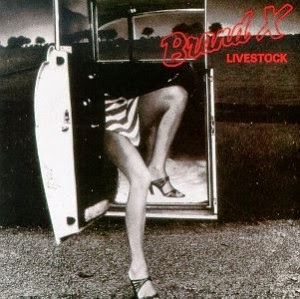BRAND X: LIVESTOCK (1977)
1) Nightmare Patrol; 2) -Ish;
3) Euthanasia Waltz; 4) Isis Mourning, Pt. 1; 5) Isis Mourning, Pt. 2; 6)
Malaga Virgen.
Live albums by fusion artists are somewhat of a
puzzle — first, because fusion as such always tends to be associated with the
«live-in-the-studio» principle, what with its being the rock-era inheritor to
classic jazz and all; second, because jazz-rock musicians are simply not
expected to wear different faces for their studio and live avatars. So, unless
the live album consists entirely of new material, its only purpose would be to
prove that the actual musicians in the band are, indeed, cunning and dexterous,
and can keep a tight groove going in real time — and even so, that would be
thin proof, since nobody knows to what extent the results could be doctored in
the studio. Unless you want to be real obnoxious about it and compare them
with bootlegs. But are there really people in this world who are obsessed with
hunting for Brand X bootlegs?
Anyway, Livestock
was put together from recordings that cover a period of one whole year and two
different drummers: three tracks were culled from London club gigs with Collins
and two more — from an August 1977 concert at the Hammersmith Odeon with
Kenwood Dennard, replacing Collins who had only just completed his duties for
Genesis' Wind & Wuthering tour.
And it does have to be admitted that much of the material is new: ʽEuthanasia
Waltzʼ and ʽMalaga Virgenʼ are the only tracks (though they do take up more
than a third of the album) to have been previously available. Not that the new
material sounds all that difficult from the old one, though — but then, nobody
would expect it to.
As it happens, they could have omitted the
references to «live» altogether. The tracks either fade in or fade out; the
audience response is limited to maybe just a couple seconds of applause every
now and then; and there is no stage banter whatsoever (according to the «if you
don't sing, you don't speak, either» principle that is also rather typical of
the instrumental jazz tradition). The two songs taken over from the studio
catalog are almost totally identical to the studio versions (except for muddier
production values in the live setting), and so the album's real worth lies in
the new material — not because it is live, but because it is new.
From that point of view, the opening ʽNightmare
Patrolʼ is one of their best compositions from that period — it does have a
slightly ominous, nocturnal atmosphere to it, if not necessarily nightmarish,
as well as a dreamy-poetic guitar riff and an involving adventurous mid-section
in which they show themselves able to build up suspense and then happily
release it to everybody's relief and satisfaction. It is also the first track
to feature the new drummer who shows himself quite worthy of the crown,
although, for my money, his fills and rolls are not nearly as smooth and totally
natural-sounding as Phil's.
The central composition on Side B is ʽIsis Mourningʼ,
where they bring down the tempo and try to inject a little «soul» — lots of
atmospheric synthesizers and weepy bluesy soloing, but the focus is still on
group playing, so neither Lumley nor Goodsall get to properly show off just how
passionate, loud, and overflowing with salty excretions Isis could be in
mourning. So, instead of trying to be moved to tears ourselves, we should
probably just enjoy the interplay instead — the way Goodsall and Jones trade
licks, arpeggios, scales, and occasional dissonances around each other once the
tempo slows down and they get a better chance to impress us with the musical
dialog. Hardly unique, but fun, and they never hang around one repetitive
theme or gimmick for too long — Goodsall, in particular, has this knack for
frequently changing the tones and effects within a short time, so once you get
close to getting tired of hearing him do minimalistic jazz licks, he'll sense
that and start spitting out funky wah-wah chords, before going into 12-bar
territory and back to jazz guitar again.
Still, the fact remains that as a composition, only ʽNightmare Patrolʼ
seems to have stick-around potential — the rest are more like temporary vamps,
enjoyable because of the players' professionalism and creativity, but hardly
pretending to much else. Throwing in the album's slightly inferior sound
quality (as compared to the studio albums, of course — on the whole, the
recording is perfectly acceptable), I would certainly not recommend it as a
point of entry. Once you have become a Brand X fan for life by assimilating Unorthodox Behaviour and Moroccan Roll, feel free to proceed.
Or, at least, take additional advice from some genuine fusion expert, the kind
of person who can actually offer a serious opinion on why one fusion album is
«better» than another fusion album — my own opinions here are as innocently
amateurish as any thoughts I might have on global warming or the Big Bang.

No comments:
Post a Comment
Note: Only a member of this blog may post a comment.